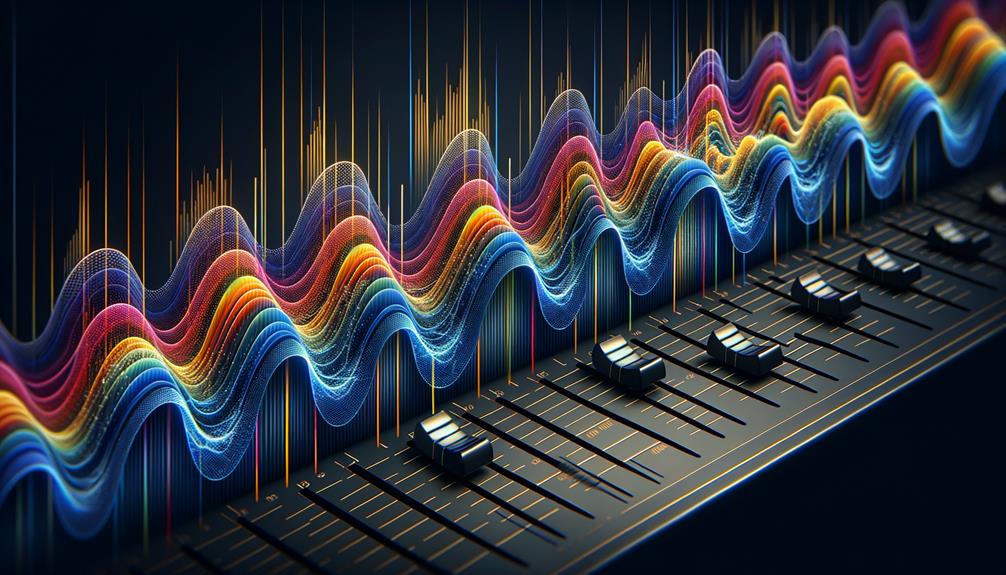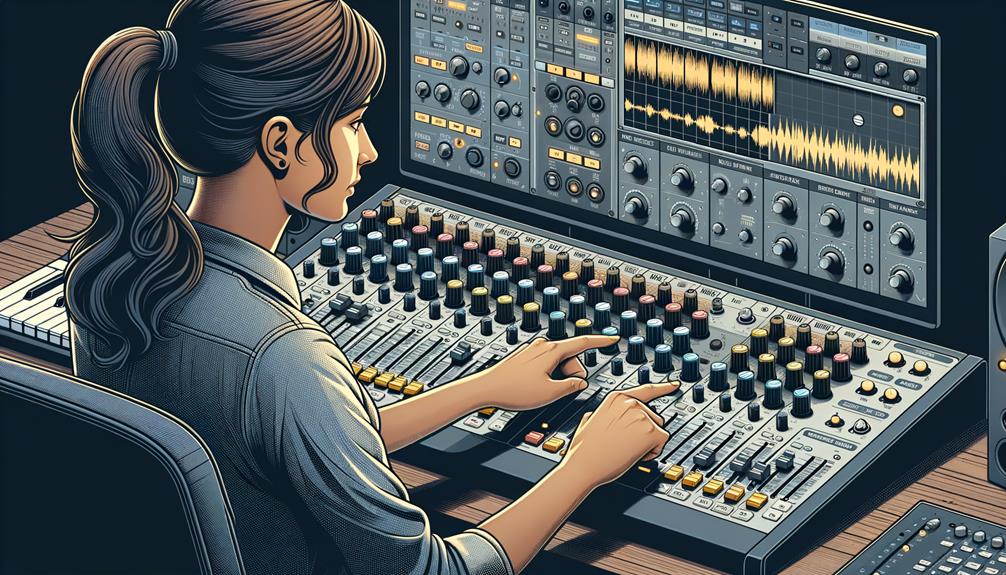No products in the cart.
So, you’ve probably heard about the concept of dynamic EQ, but what exactly does it entail? It’s more than just your standard equalizer – dynamic EQ adds a layer of adaptability that can significantly enhance your audio productions.
But how does it differ from traditional EQ, and what benefits does it offer? Well, let’s just say that dynamic EQ might just be the missing piece in your quest for precise and transparent control over your sound.
Intrigued? Keep reading to uncover the intricacies of this powerful mixing tool and how it can elevate your audio engineering game.
Contents
hide
Key Takeaways
- Dynamic EQ adjusts parameters in real-time based on the incoming signal’s characteristics.
- It provides a dynamic and precise approach to frequency control.
- Dynamic EQ automatically adjusts the gain of specific frequency bands in response to the input signal’s level.
- It offers precise and transparent control over problematic frequencies without affecting the overall tonal balance.
Dynamic EQ Explained
Dynamic EQ adjusts its parameters in real-time based on the incoming signal’s characteristics, offering a dynamic and precise approach to frequency control. Unlike traditional EQ, dynamic EQ responds to how the frequency content of the input signal changes over time.
It functions by automatically adjusting the gain of specific frequency bands in response to the input signal’s level, providing a more flexible and targeted approach to frequency shaping. This dynamic nature allows for precise and transparent control over problematic frequencies without affecting the overall tonal balance.
When a specific frequency becomes too dominant or problematic, dynamic EQ can be used to attenuate it, similar to how a multiband compressor operates. However, dynamic EQ offers a more nuanced and surgical approach, enabling gain changes only when the problematic frequency is present, while leaving the rest of the frequency spectrum untouched.
Additionally, it incorporates attack and release parameters, allowing for fine-tuning the responsiveness of the EQ to the input signal, giving you unrivaled control over the frequency dynamics. To aid in identifying problematic frequencies, dynamic EQ often includes a spectrum analyzer, further enhancing its precision and usability.
Understanding EQ Fundamentals
As you dive into the fundamentals of EQ, you’ll gain a deeper understanding of its essential principles and how they intertwine with the dynamic nature of dynamic EQ. Understanding EQ fundamentals is crucial for grasping the intricacies of dynamic EQ and its application in modern mixing.
- Parametric EQ: This type of EQ allows for precise control over specific frequencies, including the ability to adjust the bandwidth, gain, and center frequency of the selected frequency band.
- Frequency Spectrum: Understanding the frequency spectrum and how different instruments and vocals occupy various frequency ranges is essential for effectively applying dynamic EQ to address problem frequencies.
- Gain, Cut, and Compression: Dynamic EQ combines the capabilities of traditional EQ, offering the ability to both boost (gain) and attenuate (cut) specific frequencies, as well as apply compression based on the incoming signal strength.
How Dynamic EQ Functions

In dynamic EQ, the frequency bands automatically adjust in response to the audio signal, allowing for targeted and precise control over specific frequencies. Unlike traditional EQ, dynamic EQs offer a more flexible approach to shaping the frequency content of your audio.
This means that instead of only applying static boosts or cuts to specific frequency ranges, dynamic EQ lets you use compression in specific frequency bands, only activating when the incoming signal exceeds a certain threshold. This results in a more natural and transparent sound, as the EQ adjustments respond dynamically to the audio signal, providing a more musical and controlled result.
Dynamic EQ offers a fully adjustable way to control over the frequency content in a manner that traditional EQ can’t achieve. By dynamically adjusting the gain of specific frequency bands based on the level of the input signal, dynamic EQ can effectively target and tame problematic frequencies, resulting in a more balanced and polished mix.
This innovative approach to EQ allows for a more nuanced and precise sculpting of the audio, providing a powerful tool for enhancing the clarity and impact of your sound.
Dynamic EQ Versus Multiband Compression
Compared to multiband compression, the hybrid dynamics style of dynamic EQ blurs the line between frequency and dynamics, automatically adjusting the amount of EQ applied based on the incoming signal.
Here’s how dynamic EQ stacks up against multiband compression:
- Frequency Band Precision: Dynamic EQ allows for precise control over specific frequency bands, making it a versatile mixing tool for addressing problematic frequencies in a targeted manner.
- Adaptive Attenuation and Boost: Unlike multiband compression, dynamic EQ can adaptively attenuate or boost frequencies based on the input signal’s strength, providing a more nuanced and dynamic approach to frequency control.
- Resonance Handling: Dynamic EQ is effective in managing resonances in a singer’s voice or any instrument, as it can dynamically adjust the amount of EQ applied to ensure that resonance is still present without becoming overpowering.
Practical Applications of Dynamic EQ


To effectively apply dynamic EQ in practical settings, it’s essential to understand its adaptability in addressing specific frequency imbalances. Unlike traditional EQ, dynamic EQ works by automatically adjusting the EQ based on the incoming signal, providing a more flexible and precise control over the frequency balance.
One practical application of dynamic EQ is in attenuating distracting frequencies during louder moments of a performance, ensuring a more consistent and pleasant listening experience. This feature is especially beneficial for vocals and acoustic instruments, where dynamic EQ can provide transparent control without altering the overall tonal quality.
Many audio engineers have noticed that dynamic EQ offers a more natural and musical result compared to static EQ or multiband compression. Applying EQ dynamically allows for targeted boosts or cuts only when needed, without affecting the surrounding frequencies.
Moreover, dynamic EQ provides a more nuanced approach to shaping the sound, allowing for more precise adjustments to the bandwidth of an EQ, making it a powerful tool for mixing, mastering, and live performance.
Frequently Asked Questions
Is Dynamic EQ Better?
Dynamic EQ offers a better solution in audio mixing by providing precise control over the frequency and dynamic range. It enhances sound processing, signal manipulation, and tone shaping compared to traditional equalization techniques, making it a valuable tool in modern audio engineering.
How Does a Dynamic EQ Differ From a Traditional EQ?
Dynamic EQ differs from traditional EQ by dynamically adjusting frequency response based on audio modulation and dynamic range. It offers precise signal processing and control over frequency bands, shaping sound with dynamic adjustment and EQ modulation for innovative audio manipulation.
What Is the Difference Between Parametric and Dynamic Eq?
When comparing parametric and dynamic EQ, consider the real-time adjustment and dynamic control of frequency bands. Dynamic EQ offers spectral shaping within a dynamic range, providing innovative signal processing for audio engineering.
Is a Dynamic EQ a Compressor?
Dynamic EQ is not just a compressor. Understanding Dynamic EQ vs Compression is essential. It has diverse applications in mixing, mastering, live sound, recording. Dynamic EQ techniques give precise control over frequency balance and are crucial for creating balanced mixes.
Conclusion
In conclusion, dynamic EQ is a versatile and powerful tool that combines the benefits of traditional EQ with dynamic control.
It offers precise frequency correction, attenuation of unwanted frequencies, and transparent sound control.
By automatically adjusting the amount of EQ applied based on the incoming signal, dynamic EQ blurs the line between frequency and dynamics, making it an essential tool for modern mixing and sound shaping.




